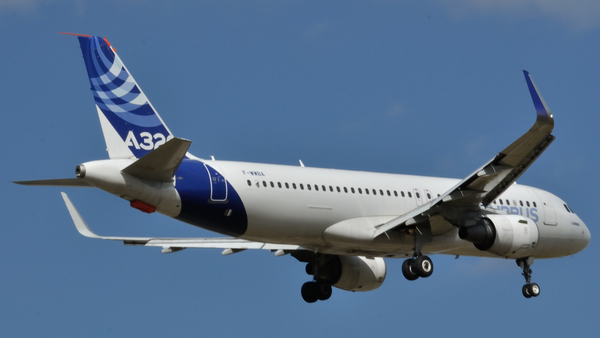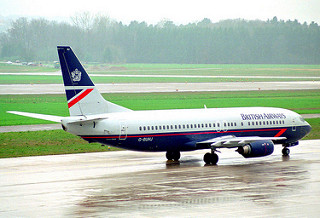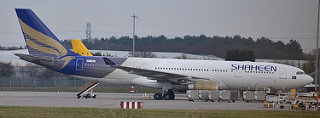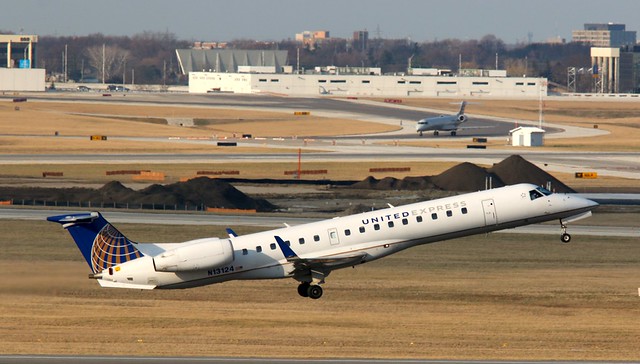Shaheen B734 at Lahore on Nov 3rd 2015, runway excursion, both main gear collapsed
Last Update: September 27, 2017 / 17:03:50 GMT/Zulu time
Incident Facts
Date of incident
Nov 3, 2015
Classification
Accident
Cause
Runway excursion
Airline
Shaheen Air International
Aircraft Registration
AP-BJO
Aircraft Type
Boeing 737-400
ICAO Type Designator
B734
Cockpit crew landing the aircraft through unstabilized approach (high ground speed and incorrect flight path).
- Low sink rate of left main landing gear (LMLG) as it touched down and probable presence of (more than the specified limits) play in the linkages of shimmy damper mechanism. This situation led to torsional vibrations / breakage of shimmy damper after touchdown. The resultant torsional excitation experienced by the LMLG due to free pivoting of wheels (along vertical axis) caused collapse of LMLG.
- The RMLG collapsed due to overload as the aircraft moved on unprepared surface.
In addition the SIB released following medical findings:
- According to the laboratory investigation reports in respect of Captain, the blood alcohol level was 83 gm/dl. The impairment of Central Nervous System starts at 50 mg/dl or above that may result in judgmental errors as evident in this case. Moreover, the blood lactate level of 70 gm/dl interprets fatigue due to increased stress as the normal level ranges from 4.5 to 23 mg/dl.
- All the medical investigation reports in respect of First Officer are within normal limits except the blood lactate level (27 mg/dl) is slightly raised than the upper normal limit of 23 mg/dl which may be raised due to stress after the accident.
The SIB reported the captain (59, ATPL, 19,302 hours total, 4,859 hours on type) was pilot flying, the first officer (34, ATPL, 2,076 hours total, 410 hours on type) was pilot monitoring. The SIB stated: "There were signs of Alcohol consumption (in the blood test) by the Captain prior to undertaking the mishap flight."
The SIB reported runway 36R at Lahore was not available due to upgrade works to install a CAT III ILS on that runway. A VOR/DME approach to runway 36L was availble.
The SIB analysed:
The Captain conducted a short departure brief which included taxi route and Standard Instrument Departure (SID). He did not discuss destination aerodrome weather conditions, diversion to alternate aerodrome and landing on runway 36L through VOR DME which was an uncommon practice requiring attention. ...
The flight climbed to its cruising altitude as planned and remained uneventful during cruise. Before initiating descent as per flight plan, the cockpit crew obtained latest weather of destination aerodrome (OPLA) which mentioned visibility 1200 meters. This visibility was below the minimum required (1600m) for carrying out a VOR DME approach and necessitated decision for diversion to alternate aerodrome. The cockpit crew decided to continue for the destination. ...
At 0359:02 UTC the flight changed over to Lahore ACC. Lahore ACC cleared the mishap flight for arrival to Lahore for VOR DME approach runway 36L. The Captain asked FO to request Lahore ACC for “ten miles finals runway 36R, initially” which was complied. Lahore ACC declined clearance for runway 36R and informed cockpit crew that the requested runway was not available due scheduled maintenance and also passed on latest weather as “ Lahore weather warning for poor visibility due mist up till 0700E and present visibility 1200 meters”. According to FO they were planning to follow ILS procedure for runway 36R with intention to break off after acquiring visual with the runway and landing at runway 36L. This was a non standard procedure.
At 0404:29 the FO tried twice to contact Sialkot International Airport (an airport in near vicinity of AIIAP, Lahore) to obtain her weather (the alternate aerodrome as per flight plan was Peshawar). The radio contact with Sialkot was not established. At this time, the FO discussed with the Captain that in case of diversion their alternate aerodrome was Peshawar and it required additional fifty minutes of flying time.
At 0404:57 the FO asked Captain whether they had to go for RNAV. The Captain told him to request for RNAV approach. The aircraft was not equipped with mandatory navigation equipment (GNSS) required for carrying out RNAV approach and the operator had also issued necessary instructions in this regard, also this decision was contrary to recommended procedure i.e. ICAO Doc 9613 para 3.4.1.1 and 3.4.1.2. At this stage, when the FO was cross checking the arrival procedure on Flight Management Guidance Computer (FMGC) he apprised the captain that by mistake the captain had selected runway 18L instead of runway 36L, which was later on accepted by the Captain and the FO was advised to change the arrival procedure. The conversation between Captain and FO at this time indicates that the Captain had difficulty in identifying / reading and feeding the correct arrival procedure due to inability in concentration.
The FO was continuously found to be prompting the Captain for decision making. In order to calculate RVR for VOR DME approach runway 36L as given in Jeppesen Chart 13-5, the FO calculated RVR as 1800 meters by multiplying visibility (1200m) with 1.5. He lacked the knowledge of RVR calculation procedure and did not consider availability of other services at runway 36L, like high intensity approach lighting system (HIALS) or high intensity runway lights (HIRL) as mentioned in Jeppesen General Airway Manual p.200 appended below. Incorrect calculation of RVR was not corrected by the Captain as well.
As per criteria mentioned in above table, RVR was same (1200m) as the reported visibility due to other type of lighting system (SALS 420M) installed on runway 36L. The required RVR for carrying out a VOR DME approach by Cat C airplane at runway 36L of OPLA as per Jeppesen Chart 13-5 was 1600m.
At 0412:15 UTC, the cockpit crew changed over to Lahore Approach Frequency as cleared by Lahore ACC. As the FO contacted Lahore Approach and informed that the flight was handed over to her and it was descending from FL 240 to FL150. Lahore Approach found the flight being right of track and inquired cockpit crew by asking them, if they were right of track. The Captain quickly asked FO to tell Lahore Approach that they were following RNAV procedure for runway 36L. The FO complied with the Captain’s instructions. Lahore Approach acknowledged that and directed the FO to report position LEMOM while continuing descend to FL 70. Lahore approach acknowledged Captain’s decision to follow RNAV and did not pursue for her previous clearance for VOR DME approach runway 36L and change of procedure to RNAV at this stage.
At 0416:52 UTC Lahore Approach cleared mishap flight for RNAV LEMOM ONE CHARLIE arrival runway36L, “descend down to 3000 ft on QNH 1018 hecta pascal and report position ELAMA”. The FO acknowledged the approach by correctly reading back. The flight turned right from hdg 040° to 070° while descending through 10300ft, with speed reducing through 273 kts and at a distance 27.4 NM from thresholds runway 36L.
- At 0420:18 UTC Lahore Approach observed the flight passing through FL85 at 20 track miles which was approx 2000-2500 ft higher than the assigned altitude. At this time, the cockpit crew selected Flaps-1, 2 and 5 in quick succession in order to increase the ROD, however speed brakes were not used here. Lahore Approach contacted cockpit crew to reconfirm whether they will be able to make approach or will discontinue due to being high. The Captain immediately prompted FO to reply by saying “Affirmative”. The FO replied as “affirmative, we can make it”.
- At this stage, it is established that the flight was neither following the track (it was right of track) nor the assigned altitudes as per ATC clearance / relevant chart. The cockpit crew lacked desired situational awareness due to stress of poor visibility combined with loss of concentration of Captain probably due to effects of alcohol, yet they wanted to continue for the landing at destination airport.
- At 0420:47 UTC the FO suggested the Captain to use the Speed Brake so that the flight can quickly descend to desired altitude. The captain in response voiced “haye...haye...haye” indicating that he was exhausted and unable to cope up with the difficult situation.
- At 0422:05 UTC the Captain asked FO to lower Flaps-10 and lower Landing Gears. The FO complied with the instructions and confirmed. The Captain again voiced “haye...haye...haye”. At this stage, they also lowered Flaps-15, Landing Light - On and Flaps-30. The Captain asked FO to complete landing checklist which was successfully done by the FO.
- At 0422:50 UTC the flight was approaching over ELAMA at 5400 ft, 9.7NM from thresholds (runway 36L) at speed approx 180kts.
- At 0422:53 UTC when the flight reported her position over ELAMA, the Lahore Approach Control observed her to be at 5000 ft altitude instead of already cleared 3000 ft. The duty controller cautioned cockpit crew by telling them that their altitude at ELAMA should have been 3000 ft whereas he had observed it to be 5000 ft. He also advised them to continue at pilot’s own responsibility; if they end up carrying out missed approach, they should continue to maintain runway heading and also advised to contact tower. By these instructions, it appears that the Lahore Approach Controller was quite certain that the flight would end up carrying out missed approach due to being very high on approach.
- After reaching over ELAMA, the flight turned left heading 355° and lowered Flaps-30. The speed at this time was 180 kts and flight was descending through 5000 ft.
- At 0423:52 UTC the Captain disengaged the autopilot at 9NM from RWT to lose the excess height by increasing ROD also executed turns to acquire the runway. However, the captain’s decision to disengage autopilot at this stage without being visual with the runway increased his workload. Resultantly, the aircraft descended with very high ROD from 2000 – 3500 ft/min. The excessive ROD with Flaps-30 selected resulted in exceeding flap speed limit.
- By the time the flight reached 4.6 NM from runway threshold lines, her parameters were hdg 356°, Ht 1211ft, speed 170 kts and ROD 1300 ft/min which were almost correct at this distance from the runway but still not visual with the runway (the cockpit crew was actually carrying out VOR DME approach against their R/T communication of RNAV approach for which the aircraft was not suitably equipped). The Captain kept flying the aircraft with no visual cues due poor visibility, increased stress level, loss of situational awareness and reduced mental ability which led to ending up low on approach with high speed. Important flight parameters on final approach below 1000 ft AFE are tabulated below which indicate that the approach had become unstabilized.
...
At 0424:02 the Captain asked FO whether the runway was visible. The FO replied in negative and advised Captain to engage the autopilot, which could make runway contact easy. However the autopilot was not engaged.
At 0424:16 the cockpit crew reported their position to ATC Tower which was 04 DME runway 36L. The duty controller at ATC Tower replied ,” recheck landing gears down & locked, wind calm, caution for birds and cleared to land runway 36L”. The FO acknowledged by saying, “cleared to land when field in sight, Shaheen 142”.
At 0424:32 the Captain continued to fly the aircraft and FO kept assisting him till they reached 500 ft AGL. The FO rechecked missed approach procedure and reset flight directors for a possible go around.
At 0425:24 when the system sounded “Five Hundred”, the Captain once again asked FO whether runway was visible. The FO replied in negative. As the airplane was descending through 460 ft AGL, constant airspeed of 150 kts was maintained. The calculated airspeed for the weight of the aircraft at landing was 136 kts.
At 0425:41 the FO kept on guiding the captain to turn right, just before the system sounded “Minimums” the FO picked up visual with the runway towards right. The FO also took over the controls and asked Captain to inform ATC that runway was in sight. The aircraft temporarily levelled off at 400 ft AGL for approximately 7 seconds and simultaneously a right turn was initiated. While descending below 400 ft AGL, the vertical speed kept varying between -1100 ft/min to -180 ft/min. At 200 ft AGL, power was advanced to 55%-65% which increased airspeed and temporarily decreased sink rate. Although the FO picked up visual with the runway at Minimum Descend Altitude (MDA) by chance, however since the approach parameters in terms of ”correct flight path” were not attained, a go around should have been initiated instead of efforts to align / land.
At 0425:47 the Captain also sighted the runway (at approximately 150ft AFE) and took over the controls from FO. However, the Captain was still unable to correctly align the aircraft with the runway, as the aircraft had ended up towards right side of the runway and a left turn was required. The FO was found asking the Captain to turn left but not only the Captain was unable to acknowledge the gravity of non normal situation he advised FO to ‘relax’. The FO responded by saying “Ok...you had ended up well towards right of runway”.
At 0426:07 soon after this the system sounded “One Hundred”, FO made an effort to take over the controls from the captain in order to land the aircraft. The captain was heard uttering “Haye... Ok... Haye... Oh...” indicating total exhaustion and inability to cope up with the difficult situation. The Captain was unaware that he was still holding the controls despite handing over to FO. The FO was heard urging the Captain to leave the controls by saying, “Chorain... aap chorain... chorain...” {Leave it... you... Leave it... Leave it}. The Captain again voiced, “Haye...Oh”. The FO was busy in landing the aircraft while Captain kept uttering exhausting voices besides being hyperventilated.
At 0426:13 the aircraft had reached its flare out height and system sounded “Fifty...Forty...Thirty...Twenty...Ten” and both throttles were retarded to idle. The aircraft touched down 1400 ft down form threshold lines in left half of the runway on right wheel in a right
bank angle of 8°, a nose up attitude of 1.5° and 4.5° crab angle while the Captain and FO both were holding the controls and FO was making the landing. According to FDR data, the touchdown speed was 174 kts ground speed/166 kts True Airspeed against 134 kts of reference speed (Vref). Auto-speed brake got deployed at touchdown since it was armed. Thereafter, the aircraft slightly bounced and left wheel touched down the runway surface followed by second touching down of right wheel. When the left wheel touched down the left main landing gear broke following a shimmy event. Thrust reversers and brakes were applied, as speed brake was armed before landing. The mishap aircraft departed runway towards left on fair weather strip due to high drag generated by rubbing of left engine cowling with the runway surface. Soon after MA departed the runway on soft ground, the right main gear also broke. The MA was now resting on both engines and nose wheel which remained intact throughout. The MA continued to skid on fair weather strip for 8000 ft before coming to final stop. Throughout landing roll the Captain and FO remained quiet and did not talk for any action till aircraft stopped. Thereafter since the captain did not ask FO for Engine shutdown checklist and evacuation of passengers. The same was accomplished by the FO. No passenger was injured during the incident or during emergency evacuation.
The SIB reported the aircraft touched down at +1.75G at a 174 KTAS and 166 knots over ground at a bank angle of 8 degrees to the right and about 1.5 degrees nose up. The right outer main tyre made first contact with the runway 1394 feet past the runway threshold and 28 feet and 28 feet left of the center line.
The inboard left main tyre touched down 2020 feet past the runway threshold and 56 feet left of the runway center line, the outer tyre touched down about 10 feet later. Both tyre marks continued straight for 30 feet then began zigzagging. Several pieces separated and were later found on the runway. 2650 feet past the runway end the left engine cowling contacted the runway surface, the left main gear did not immediately detach after the collapse and came to rest 4540 feet past the threshold.
Pieces of the right hand main tyres were subsequently found left of the runway, obviously the tyres broke after the aircraft encountered a brick lining off the runway on soft ground 6996 feet past the runway threshold and 10 feet off the left edge of the runway. The right main gear collapsed and the right engine cowling contacted soft ground.
The aircraft came to a stop 8302 feet past the runway threshold and 197 feet left of the runway center line.
The SIB analysed that the left main gear touched down at a rate of 1 foot per second, the very low sink rate suggests that the left main gear did not experience a hard landing. The inboard tyre touching down first followed by the outboard tyre exerts torsional loads onto the landing gear any may excite torsional vibrations.
Incident Facts
Date of incident
Nov 3, 2015
Classification
Accident
Cause
Runway excursion
Airline
Shaheen Air International
Aircraft Registration
AP-BJO
Aircraft Type
Boeing 737-400
ICAO Type Designator
B734
This article is published under license from Avherald.com. © of text by Avherald.com.
Article source
You can read 2 more free articles without a subscription.
Subscribe now and continue reading without any limits!
Read unlimited articles and receive our daily update briefing. Gain better insights into what is happening in commercial aviation safety.
Send tip
Support AeroInside by sending a small tip amount.
Related articles
Shaheen A320 enroute on Feb 25th 2018, hail strke
A Shaheen Airbus A320-200, registration AP-BLK performing flight NL-224 from Dubai (United Arab Emirates) to Islamabad (Pakistan), was enroute when…
Shaheen A319 at Lahore on Aug 16th 2017, cabin did not pressurize
A Shaheen Airbus A319-100, registration AP-BNJ performing flight NL-766 from Lahore (Pakistan) to Dubai (United Arab Emirates), was climbing out of…
Shaheen B734 at Sharjah on Sep 24th 2015, took off from taxiway
A Shaheen Boeing 737-400, registration AP-BJR performing flight NL-791 from Sharjah (United Arab Emirates) to Peshawar (Pakistan) with 148 passengers…
Shaheen A332 near Lahore on Jan 8th 2017, engine fire indication
A Shaheen Airbus A330-200, registration AP-BML performing positioning flight NL-902D from Manchester,EN (UK) to Lahore (Pakistan) with just 10 crew,…
Shaheen A320 at Lahore on Jun 2nd 2016, rejected takeoff due to engine problem, tyre damage
A Shaheen Airbus A320-200, registration AP-BLH performing flight NL-766 from Lahore (Pakistan) to Dubai (United Arab Emirates) with 160 people on…
Newest articles
The GPS Problem No One Wants to Discuss in 2026
GPS is widely perceived as a solved problem. It works, it’s global, and it underpins everything from smartphones to financial systems. Yet in…
Commute ERJ145 at Washington on Jan 12th 2026, engine shut down in flight
A Commute Air Embraer ERJ-145 on behalf of United, registration N13124 performing flight UA-4295 from Washington Dulles,DC to Mobile,AL (USA) with 43…
Subscribe today
Are you researching aviation incidents? Get access to AeroInside Insights, unlimited read access and receive the daily newsletter.
Pick your plan and subscribePartner

ELITE Simulation Solutions is a leading global provider of Flight Simulation Training Devices, IFR training software as well as flight controls and related services. Find out more.
SafetyScan Pro provides streamlined access to thousands of aviation accident reports. Tailored for your safety management efforts. Book your demo today
AeroInside Blog
Popular aircraft
Airbus A320Boeing 737-800
Boeing 737-800 MAX
Popular airlines
American AirlinesUnited
Delta
Air Canada
Lufthansa
British Airways





